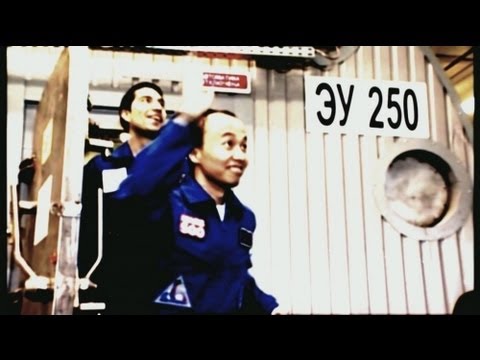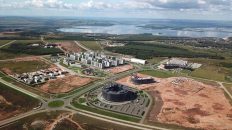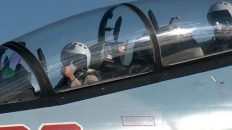After 520 days of total isolation in a mock spaceship, the Mars 500 crew were reunited with their loved ones in the outside world.
In this edition of Space we have the men’s first accounts and exclusive images of their sealed capsule. We also witness the aftermath and follow their medical and psychological check ups. Finally, we discover just how important this simulated trip to nowhere could be for future, space exploring generations.
It’s the end of a long journey for the six volunteers who didn’t step outside for a year and a half. The final stage of the Mars-500 experiment became the first full-length simulation of a human mission to our neighboring planet.
Diego Urbina, European 520-day isolation study crew member: “On the Mars-500 mission, we have achieved on Earth the longest Space voyage ever, so that humankind can one day greet a new dawn on the surface of a distant but reachable planet.”
The crew of three Russians, one Chinese and two Europeans were sealed in their spacecraft mock-up at the Russian Institute of Biomedical Problems – IBMP – that carried out the experiment in cooperation with the European Space Agency.
Romain Charles, European 520-day isolation study crew member: “We’ll first present Diego’s room. I guess you’ve noted the Italian flag. Just next door you have my room.”
Diego Urbina, European 520-day isolation study crew member: “This is the shaft that communicates the living quarters with the gym. And here we have an airlock through which we pass all the samples to scientists around the world.”
Obviously, some aspects of an interplanetary flight – such as the space radiation and weightlessness – couldn’t be simulated. But the Mars-500 study provided priceless data on medical and psychological effects of the long isolation on a spaceship crew. The culturally diverse group had to avoid conflicts and keep the team spirit up through the long and stressful mission, lacking the real-time contact with the rest of the world and having no one else to rely on in an emergency.
Christer Fuglesang, Head of Science and Application Division, Directorate of Human Spaceflight and Exploration, ESA: “They did exceptionally well. I mean, no real conflicts – I think most people would have expected things like that.”
Anatoly Grigoriev, Vice-president, Russian Academy of Sciences, IBMP Scientific Director: “The crew coped with their task not only in normal conditions, but also in emergency situations…”
… such as the sudden blackout in December that left the crew without without water, electricity and ventilation for 20 hours.
Patrik Sundblad, Head of Life Science Unit, Directorate of Human Spaceflight and Operations, ESA: ”The crew actually didn’t realize that it was a simulation, and it took us a couple of weeks to convince them that this was not for real, it was only an exercise.”
Now that their isolation is over, the Mars-500 crew members enjoy their first sunrise in 17 months.
The post-mission quarantine is the best time for medics and scientists to measure the effect of the experiment on the six volunteers’ health.
This aerospace clinic in Moscow uses the same diagnostic equipment to examine cosmonauts, jet pilots and submarine crews.
The post-mission check-ups will complement the data collected in more than a hundred international scientific investigations throughout the study.
Patrik Sundblad, Head of Life Science Unit, Directorate of Human Spaceflight and Operations, ESA: “Since the focus here is the isolation and confinement aspects of the Mars mission, the focus has been largely on behavioral performance and psychological function, the functioning of the team, but also the effects of the stress of isolation, and the effects that stress has on different physiological functions, like the immune function, for example.”
Romain Charles: “Welcome to the medical module – this is our workplace, and this is the place where I’ll spend most of my time tomorrow doing some experiments with digestion.”
Diego Urbina: “We spent a large share of our time conducting the experiments programmed by scientists, gathering the data, and then sending it to them… Look at Wang – he’s all relaxed… And Sasha – he’s doing a test today, he has to blow in the tubes every half an hour… and have this device connected to his chest.”
Christer Fuglesang: “The scientific goal was partly psychological – to see how we could do this; then lot of medical things – I don’t think any six healthy males have been so well controlled, followed for one and a half years. I mean, everything they ate, exactly, we controlled, and then we took a hundred or so medical tests all the time, and this will be a scientific goldmine for many years to come.”
Romain Charles: “We need to eat exactly what is written on the menu. So we have to take 20 grams of that, 20 grams of this. And as you can see, the whole module is filled with food.”
Romain Charles: “OK, this is the way how Diego is making a cocktail.”
The fresh food is certainly a welcome change for the crew after the 520 days of the stocked supplies, almost identical to the diet used for the International Space Station.
In the meantime, the search for hazardous after-effects continues.
Philippe Arbeille, Director, Unité Médecine & Physiologie spatiale, Tours University (FR) : “We do an ultrasound image of the blood vessels and heart. The images we see show the vessel wall has a certain thickness, and we think this thickness may change eventually…with effects of inactivity and the distress of the flight.”
The Mars-500 study became the latest and the largest in the long series of isolation tests conducted at the IBMP since the dawn of the piloted space flight.
Back then, a manned mission to Mars was a daring goal of the Soviet rocket engineers, aiming to challenge the american Moon landing.
In 1967, three researchers led by German Manovtsev were sealed for one year in a tight steel chamber to test the autonomous life support systems. The module measured just 12 square meters and didn’t provide any personal space for the increasingly irritated crew members.
German Manovtsev, Leading Research Fellow, Institute of Biomedical Problems: “For a whole year, we dwelled in that confined space. When two people were sitting at the table, the third couldn’t make his way past without brushing someone. You can imagine how that starts to get on your nerves after a year.”
Boris Morukov, Deputy Director for Science, Institute of Biomedical Problems: “That study was and remains an extraordinary achievement. The experience gained back then, as well as some elements of that study, were used in the Mars-500 and in the real space flights”.
Unlike all the previous experiments, the Mars-500 study included a simulated ”descend” to the Martian surface.
Patrik Sundblad, Head of Life Science Unit, Directorate of Human Spaceflight and Operations, ESA: “Having a big event like this in the middle of the mission has really been something that has lifted up the crew.”
Diego Urbina: “The period on the Martian surface was by far the most exciting of all. We divided the crew into two groups, and three of us went into the landing module and landed on Mars, virtually. And there we used real space suits to do three EVAs, in two of which I was in space suit and another one I was the crew communicator.”
Alexandr Smoleevskiy, Russian 520-day isolation study crew member: “For the imitation landing on the Martian surface, the crew wasn’t divided by nationality: the landing team included representatives of China, Russia and Europe, and we had absolutely no problems communicating and working together as one team.”
The success of the Mars-500 mission was due in large part to the rigorous selection of the participants. The European members of the crew – the Italian-Colombian Diego Urbina and the French Romain Charles – were chosen from thousands of volunteers for their psychological and professional characteristics, as well as the right physical shape to stay healthy throughout the isolation.
Dieter Felsenberg, Professor, Charité – University Medicine Berlin: “Our task was to increase, or at least don’t lose the strength of the crewmembers’ muscles and bones during this experiment. We used a vibration device to preserve the muscle force, and we see if that worked by measuring that force, asking them to jump on the “ground reaction force plate”.
These German scientists use a CT scanner to compare the muscle volume and the bones condition of the crew members before and after the 520-days isolation.
Patrik Sundblad: “The data is still being collected, of course, and the scientists will work for one or two years analyzing and publishing this data.”
The Mars-500 experiment is an important milestone in preparing a real round trip to our neighbor planet. If the space-faring nations agree to cooperate in reaching that goal, the interplanetary journey may become realistic in 25 years.
Diego Urbina:“If you ask me, would I do such simulation again tomorrow – I will doubt it. It has been a long time away from my family, from all the things that I love. But if you tell me it would be a trip to Mars, I would go without doubt.”
Anatoly Grigoriev, Vice-president, Russian Academy of Sciences, IBMP Scientific Director: “I think that such trip will be very important for the humanity to understand its possibilities, and for the science to try to answer its questions about Mars. And, of course, it will be immensely important for the younger generation who need to understand that they can and should work together. There are goals that unite all those who live on Earth. This is one such goal.”





